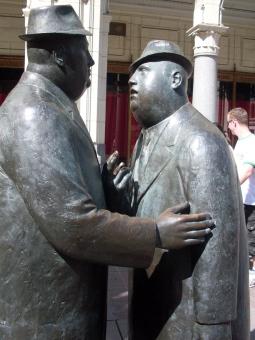It’s not every day that you see two male lovers embracing in downtown Calgary. Or maybe it is.
To many of the thousands of people who walk by it every day, the statue on Stephen Avenue that depicts two men gently touching one another probably looks the way it was intended: two business men engaged in a conversation.
But to a young, gay person, yearning for the slightest queer-friendly sign in a sometimes queer-unfriendly city, the statue on Stephen Avenue might look like two male lovers.
“When you match this image that you walk by every day on the street with this interpretation,” says 23-year-old Jasmine Ing, “it becomes very powerful because it attaches this queerness to the every day.”
Ing is one of seven youth who participated in Calgary Outlink’s queer youth photovoice project, (Eye)dentities. Photovoice is a research method that allows members of marginalized communities to share their experiences through photography.
The project, which was part of a broad consultation with Calgary’s queer communities, armed selected members of Calgary Outlink’s youth group with digital cameras and tasked them with taking pictures of their everyday lives. There was only one catch: the photos they took were to focus on aspects of their sexual or gender identities.
This can be a daunting task for someone in a city like Calgary, where queer spaces are harder to come by, says Ing. Unlike Montreal, Toronto and Vancouver, Calgary doesn’t have a designated gay village or district.
“At the beginning, I felt like I didn’t know what to take pictures of,” says Ing. “But as I went through the process, when I sat down to talk about the photos, and talk about why I took them and what I noticed in them, there was actually a lot of themes going on in my own life that I thought were important generally for the LGBT community.”
These themes include identity, belonging, visibility, resilience and pride.
Every two weeks, the participants gathered with a professor from the University of Calgary’s Faculty of Social Work to discuss the photographs and how they relate to their identities as queer youth.
“We’re hoping to share our voices not only with our peers,” says Ing, “but with the broader community… to give a human and concrete image of what it might mean for somebody to be 23 and queer.”
The images in the photographs range from two men two-stepping together to a pot of pansies on 17th Avenue to a graduation ceremony at which the students are wearing rainbow-coloured sachets, thanks to Photoshop.
Like the statue on Stephen Avenue, some of the participants took photos of objects or landmarks that aren’t intended to be queer and claimed them as their own.
Ing says it’s symbolic of the youth’s resilience.
“There aren’t that many spaces that are clearly marked as LGBT in the city,” says Ing. “So making space for ourselves even when one isn’t made for us — that’s one of the ways the youth showed resilience to a sometimes hostile environment.”
Ing’s own photos include an image of a rainbow in the sky after a rainstorm.
“That’s not something that the city put here on purpose,” says Ing, “but when I saw the rainbow, I knew I had to take a photo of it. To me, when I saw that, it felt like it was kind of marking our space in the city.”
In the end, Ing says she did find more queer-friendly spaces in Calgary than she was expecting.
“I think in participating in the project, it made me reflect on what parts of Calgary are positive to be in and what parts of Calgary are working hard on trying to make welcoming spaces for diversity, and that was really nice, because I’m here, and I’m not leaving anytime soon,” says Ing.
“We found ways to be proud of Calgary, and we also showed how we are proud of ourselves in our own sexuality or gender identity,” she added.
Twenty-five photos from the project will be unveiled Oct 21 at 10am at the Calgary Area Outdoor Council (1111 Memorial Drive NW), along with the results of Calgary Outlink’s survey and an analysis of the city’s current queer service needs and gaps.

 Why you can trust Xtra
Why you can trust Xtra


